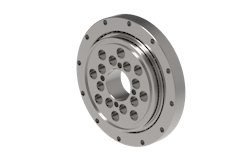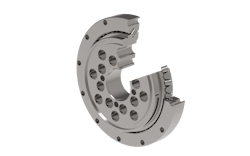Humanoid Robots: Enhancing Accuracy with Custom Crossed Roller Bearings
In humanoid robotics, achieving precise and smooth movement is essential for effective performance. Central to this are rotary actuators, which convert energy into rotational motion. The efficiency of these actuators hinges on the quality of the bearings used.
Custom crossed roller bearings play a pivotal role in optimizing actuator performance. Unlike standard actuators, these custom solutions are designed to handle specific loads, minimize friction, and ensure accurate movement, making them ideal for advanced robotic applications.
READ MORE: Automate 2024 Preview: Robotics, Vision, Artificial Intelligence, Motion Control
This article examines how custom-crossed roller bearings enhance the functionality of rotary actuators in humanoid robots by exploring their advantages, comparing standard and custom options and discussing material selection, assembly considerations and the benefits of collaborating with a bearing manufacturer.
Understanding Rotary Actuators
Rotary actuators convert energy into rotational mechanical motion, essential for accurate robotic movements. They consist of three key components:
The motor that drives the actuator—commonly electric, pneumatic or hydraulic.
The gearbox to translate motor output into appropriate rotational torque.
Bearings that facilitate smooth rotation while supporting loads. These include:
- Crossed roller bearings
- Angular contact ball bearings
- Flexible ball bearings
Understanding Crossed Roller Bearings
Crossed roller bearings consist of cylindrical rollers arranged in a crisscross pattern. This design offers several advantages:
- High load capacity. Capable of handling radial loads, axial loads in both directions, moment loads, or any combination of loads.
- Compact design. Saves space while maintaining high performance.
- Low clearance. Enhanced accuracy with low clearance and high rigidity.
- Reduced friction. Promotes smooth operation with low friction; essential for humanoid robots.
Benefits of Custom Crossed Roller Bearings
Standard crossed roller bearings are effective for general applications, but custom designs can significantly enhance actuator performance, especially in robotics. Here’s how:
Reduction of Clearance/Backlash and Friction Torque
Using crossed roller bearings with reduced clearance and friction torque in humanoid robots provides several key benefits. They improve precision and accuracy, which is extremely critical in humanoid robots. They also enhance control and responsiveness by enabling smoother movements.
Reduced friction minimizes wear, leading to longer-lasting components and less frequent maintenance. Additionally, improved energy efficiency is achieved because less energy is lost due to higher friction. Overall, these bearings contribute to smoother motion, reduced vibration and better load handling, boosting the robot’s overall performance and reliability.
Application Optimization
Custom bearings can be designed for specific applications within the robot, accommodating unique loads and motion requirements. This approach promotes durability by eliminating the risk of failure. It also streamlines the assembly process by incorporating features directly into the crossed roller bearing design, which can reduce the total number of components, as well as the weight and size. Moreover, it improves efficiency with lower clearance, lower friction and optimized load distribution, leading to better overall actuator performance.
Tailored Material Selection
Selecting appropriate materials is crucial for performance. Corrosion-resistant alloys extend the versatility of bearings, allowing use in various environments without degradation. High-strength alloys, on the other hand, improve wear resistance and extend the lifespan of bearings, making them suitable for heavy-duty applications.
Standard vs. Custom Bearings
When deciding between off-the-shelf and application-specific crossed roller bearings, consider the following factors:
|
Type |
Off-the-shelf |
Custom |
|
Pros |
|
|
|
Cons |
|
|
Things to Consider
Assembly consideration. The assembly of rotary actuators using crossed roller bearings requires careful attention to detail. The housing must maintain the correct fit for bearings to minimize binding and ensure smooth operation.
Collaborating with a bearing manufacturer. Working closely with a bearing manufacturer can yield many benefits, including:
- Design support. Assistance with bearing design to meet specific application needs. For example, to increase load capacity, a manufacturer might recommend using a full complement bearing.
- Testing and validation. Access to testing labs to validate performance under expected load conditions is a valuable resource that reduces the risk of failure.
Conclusion
In the realm of humanoid robotics, the performance of rotary actuators hinges on component precision, alignment and quality, particularly crossed roller bearings. Customizing these bearings can lead to significant improvements in accuracy, efficiency and overall functionality. By understanding the nuances of rotary actuators and the benefits of customized solutions, robotic engineers can develop more advanced, reliable and capable humanoid robots.
About the Author

Yaman Obaid
Mechanical Engineer, CCTY
Yaman Obaid is a mechanical engineer specializing in robotics for CCTY, a global manufacturer of precision motion control products with offices in China, North America, Europe, Japan and India. Click here for more information.


